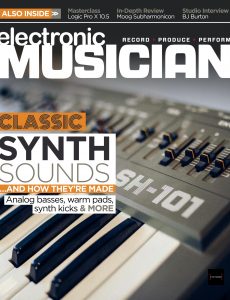
Electronic Musician – October 2020
English | 69 pages | pdf | 48.44 MB
I’m a big advocate of the idea that, in order to create unique and ambitious music, it’s first important to study the basic principles that music is based on. It’s something certainly true for anybody learning an instrument – a guitarist will always learn basic picking before attempting a lightningfast tapping solo, and a pianist will get to grips with simple triads before tackling more complex jazz chords. In electronic music making, it’s a principle that can sometimes get overlooked though. Since we have access to so many ready resources – sample packs, synth presets, project templates – it’s perfectly possible to construct and even mix full tracks without really understanding the core elements behind your ideas.
As useful and democratizing as all these resources can be, there’s still certainly something to be said for going back-to-basics and learning how your synthesizers and effects work, or the theory behind how your favorite tracks are structured. For one thing, it makes it so much easier to put your own stamp on common sounds and ideas. With a bit of know-how about classic drum rhythms, or how what goes into creating your favorite synth patch, it quickly becomes much easier to push and expand on those elements in order to create something new.
This issue’s cover feature hopefully ties into this. We’re taking a back-to-basics approach to examining some classic synth sounds, in the hope we can offer a refresher on some of the core ideas and principles. With any luck it will inspire ways to adapt and develop those simple sounds into fresh ideas!
We hope you enjoy this latest issue of EM as much as we’ve enjoyed making it! Stay safe.
Download from:
One Response to “Electronic Musician – October 2020”
Warning: call_user_func_array() expects parameter 1 to be a valid callback, function 'embed_bbcode ' not found or invalid function name in /home/magdownload/public_html/wp-includes/class-wp-hook.php on line 310